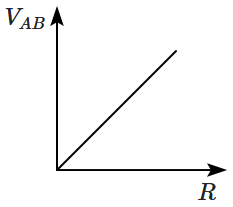Select Question Set:
Unlock IMPORTANT QUESTION
This question was bookmarked by 5 NEET 2025 toppers during their NEETprep journey. Get Target Batch to see this question.
✨ Perfect for quick revision & accuracy boost
Buy Target Batch
Access all premium questions instantly
Two cells having emfs \(3\) V and \(2\) V are connected in parallel and they give an emf of \(0.5\) V in the same sense as \(3\) V \(-\) cell. The internal resistances of the cells are \(r_1\) and \(r_2\) respectively. If one cell is reversed, their combined emf becomes \(2.5\) V. The ratio of their internal resistances \(\Big(\dfrac{r_1}{r_2}\Big) \) is:
1. \(1\)
2. \(\dfrac12\)
3. \(\dfrac21\)
4. \(\sqrt2\)
Subtopic: Grouping of Cells |
67%
Level 2: 60%+
Hints
Unlock IMPORTANT QUESTION
This question was bookmarked by 5 NEET 2025 toppers during their NEETprep journey. Get Target Batch to see this question.
✨ Perfect for quick revision & accuracy boost
Buy Target Batch
Access all premium questions instantly
In the Wheatstone Bridge arrangement shown, the resistance \(P\) is \(2~ \Omega.\) The bridge is initially balanced. If P and Q are interchanged: an amount equal to \(S\) has to be added to \(R\) to restore the balance. The resistance \(Q\) equals (nearly):

1. \(2 ~\Omega\)
2. \(3.2 ~\Omega\)
3. \(4 ~\Omega\)
4. \(6.4 ~\Omega\)

1. \(2 ~\Omega\)
2. \(3.2 ~\Omega\)
3. \(4 ~\Omega\)
4. \(6.4 ~\Omega\)
Subtopic: Wheatstone Bridge |
Level 3: 35%-60%
Hints
Current density is the current crossing per unit area. Consider a cylindrical wire of uniform cross-section \(A,\) carrying a current \(I.\) Imagine a cross-section formed by a "\(30^\circ\)-cut" as shown (the wire is not really cut). The current density perpendicular to this cross-section is:


| 1. | \(\dfrac{I}{A}\) | 2. | \(\dfrac{I}{A}~\cos30^\circ\) |
| 3. | \(\dfrac{2I}{A}\) | 4. | \(\dfrac{I}{A}~\sin30^\circ\) |
Subtopic: Current & Current Density |
Level 3: 35%-60%
Hints
A thin circular conducting wire is connected at \(A,B\) where the smaller arc \(AB\) represents \(\dfrac14^{\text{th}}\) of the circumference. A current flows from \(A\) to \(B,\) dividing into two branches \(i_1\) and \(i_2\) at \(A.\) The ratio \(i_1:i_2\) equals:


| 1. | \(3\) | 2. | \(4\) |
| 3. | \(\dfrac13\) | 4. | \(1\) |
Subtopic: Combination of Resistors |
57%
Level 3: 35%-60%
Hints
Given below are two statements:
| Statement I: | Kirchhoff’s current law is a consequence of the conservation of energy as applied to electric circuits. |
| Statement II: | Kirchhoff’s voltage law is a consequence of the conservation of charge. |
| 1. | Statement I is incorrect and Statement II is correct. |
| 2. | Both Statement I and Statement II are correct. |
| 3. | Both Statement I and Statement II are incorrect. |
| 4. | Statement I is correct and Statement II is incorrect. |
Subtopic: Kirchoff's Voltage Law |
70%
Level 2: 60%+
Hints
The resistance between \(A,B\) is found to be \(500~\Omega\) while that between \(A,C\) is \(400~\Omega.\) The minimum possible value of \(R_2\) is:

1. \(100~\Omega\)
2. \(200~\Omega\)
3. \(400~\Omega\)
4. \(900~\Omega\)

1. \(100~\Omega\)
2. \(200~\Omega\)
3. \(400~\Omega\)
4. \(900~\Omega\)
Subtopic: Kirchoff's Voltage Law |
52%
Level 3: 35%-60%
Hints
Find the equivalent resistance of the circuit between \(A,B\) shown in the figure when
(a) terminals \(C,D\) are disconnected (switch \(K\) is open)
(b) terminals \(C,D\) are connected (switch \(K\) is closed)

1. \(2.5~\Omega,~2.5~\Omega\)
2. \(2.5~\Omega,~2.4~\Omega\)
3. \(2.4~\Omega,~2.5~\Omega\)
4. \(2.4~\Omega,~2.4~\Omega\)
(a) terminals \(C,D\) are disconnected (switch \(K\) is open)
(b) terminals \(C,D\) are connected (switch \(K\) is closed)

1. \(2.5~\Omega,~2.5~\Omega\)
2. \(2.5~\Omega,~2.4~\Omega\)
3. \(2.4~\Omega,~2.5~\Omega\)
4. \(2.4~\Omega,~2.4~\Omega\)
Subtopic: Combination of Resistors |
57%
Level 3: 35%-60%
Hints
A \(20~\text V\) cell delivers the same power to a \(2~\Omega\) resistor as it does to an \(8~\Omega\) resistor. The internal resistance of the cell is:
| 1. | \(2~\Omega\) | 2. | \(4~\Omega\) |
| 3. | \(6~\Omega\) | 4. | \(1.6~\Omega\) |
Subtopic: Heating Effects of Current |
56%
Level 3: 35%-60%
Hints
The current flowing through the left \(20~\Omega\) resistor is:


| 1. | \(1~\text A\) | 2. | \(0.5~\text A\) |
| 3. | \(2.5~\text A\) | 4. | \(3~\text A\) |
Subtopic: Kirchoff's Voltage Law |
59%
Level 3: 35%-60%
Hints
The potential difference \(V_{AB}\) (in volts) is plotted as a function of the resistance \(R.\) The graph is given by:


| 1. |  |
2. |  |
| 3. |  |
4. |  |
Subtopic: Derivation of Ohm's Law |
53%
Level 3: 35%-60%
Hints
Select Question Set:






